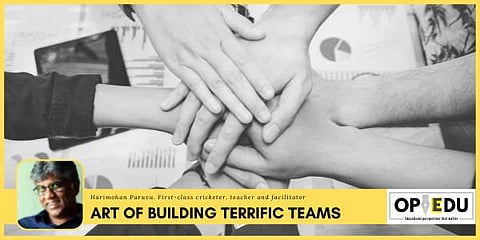E-Canteen Fundas: The why and how behind building terrific teams and making them work
‘There is so much talk about synergies and teamwork,’ said Rinku. ‘Then why do we struggle at getting the best from individuals and teams at all levels in our society?’
‘True,’ said Rahul. ‘It would help to know the secret to build the perfect team.’
‘Very valid questions,’ said Rakesh. ‘To get the best out of teams, we must get the best out of each individual. Interestingly Google addressed this issue through a two-year study called Project Aristotle on what makes the best teams tick.’
‘Really?’ said Rahul. ‘What did they find?’
‘After examining several parameters, they found five characteristics common to high-performing teams,’ said Rakesh. ‘They are — impact, meaning, structure and clarity and dependability which means that as a high performing team member you feel your work has a positive impact, find work meaningful, have clarity in goals, roles and execution plans and can depend on the others to deliver their part. But it’s the fifth characteristic that was the secret ingredient with a disproportionate impact. In fact, the other four almost don’t matter if the secret ingredient is missing.’
‘Wow?’ asked Rinku. ‘What’s that?’
‘Psychological safety,’ said Rakesh. ‘It’s not about who’s on the team, but how they interacted that mattered. They found that when all team members felt safe, trusted and respected within the team, the team performance was vastly superior. Every team member felt safe to speak up, to be vulnerable in front of their peers and to take moderate risks knowing that their mistakes will not be punished for taking action they felt was right. Team members acted without and worked to potential. On the other hand, when team members feel unsafe within the team, the team’s initiative and creativity suffered and it ended up with low performance because the team was not fully there.’
‘We never looked at this aspect,’ said Rinku. ‘Only a few members in our team speak up or take initiative and the rest follow. How can we get psychological safety going?’
‘Start these two practices,’ said Rakesh. ‘The first is conversational turn-taking, that is, allot time and have everyone talk. The second is ostentatious listening. When others speak, listen fully. Ask questions, repeat what they said. Make them feel safe enough to express themselves without fear of judgment.’
‘How do we do that?’ asked Rinku.
‘For example, model risk-taking by sharing risks you’ve taken recently that might not have succeeded. Prod others to share their stories about risks they have taken. Welcome new ideas. When everyone participates fearlessly, the team gets ideas that lead to major breakthroughs.’
‘But won’t this namby-pamby work with weak players affect our team’s edge?’ asked Rahul.
‘There are no weak players, Rahul, only untapped potential,’ laughed Rakesh. ‘Facilitate an atmosphere that brings the best out of everyone. Build a culture where mistakes are seen as opportunities to learn and not as a means to threaten, build a culture that is challenging, not threatening. Psychological safety releases the brakes from your team’s potential; it doesn’t take your foot off the accelerator. When your team has a foot on both accelerator and the brake, it won’t go far.’
‘That’s really useful,’ said Rinku. ‘I feel we could practice it in all my teams.’
Pro Tip: To make teams work to their potential, build a culture of psychological safety where team members feel safe enough to speak out and take moderate risks without fear of being judged or punished. Build a space where everyone feels trusted and respected when they act and the team performs to their potential.


